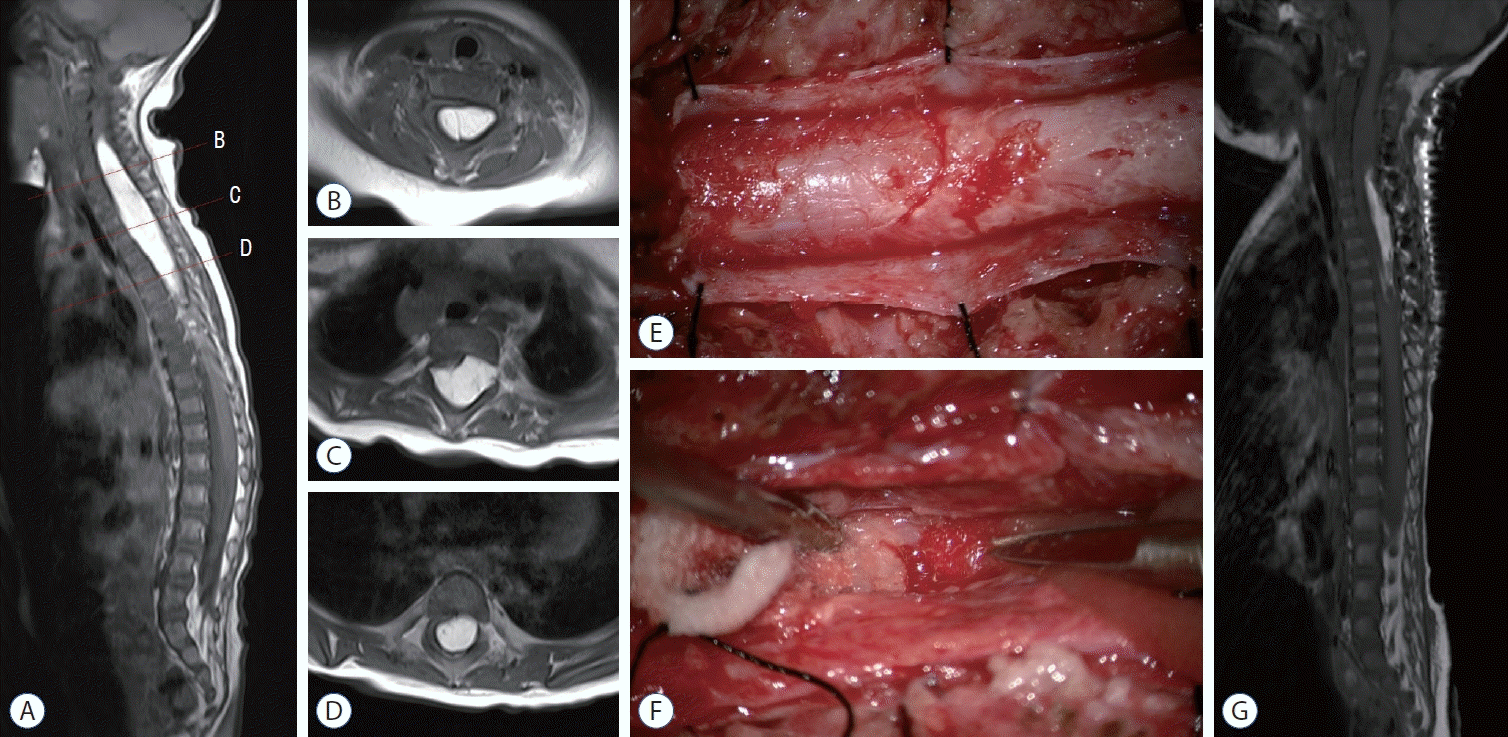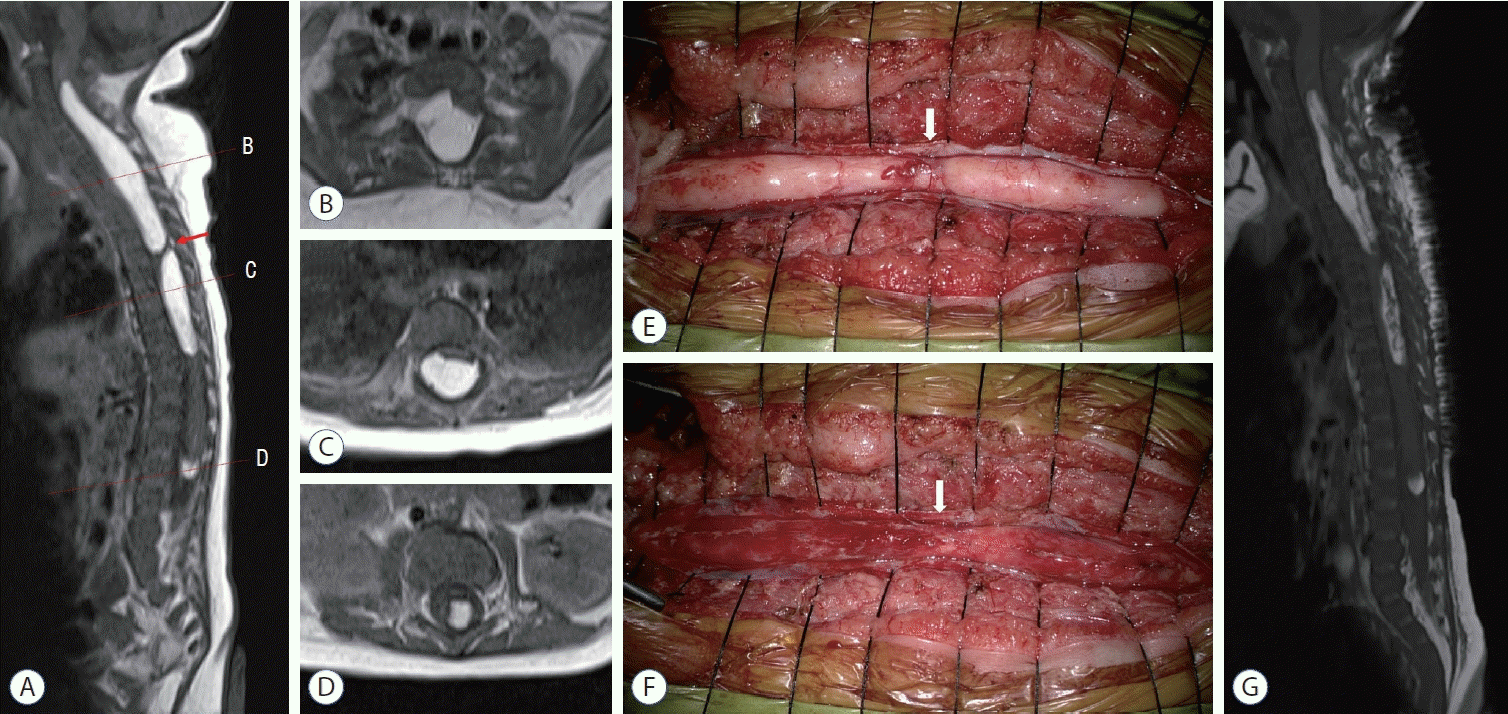1. Abuzayed B, Alawneh K, Al Qawasmeh M, Raffee L. Nondysraphic spinal intramedullary lipoma: a rare case and management. Turk Arch Pediatr. 56:85–87. 2021.
2. Bhatoe HS, Singh P, Chaturvedi A, Sahai K, Dutta V, Sahoo PK. Nondysraphic intramedullary spinal cord lipomas: a review. Neurosurg Focus. 18:ECP1. 2005.
3. Bishnoi I, Singh P, Duggal G, Sorout S. A rare case of intramedullary lipoma of brainstem to thoracic cord--what to do? J Pediatr Neurosci. 15:145–149. 2020.
4. Chagla AS, Balasubramaniam S, Goel AH. A massive cervicomedullary intramedullary spinal cord lipoma. J Clin Neurosci. 15:817–820. 2008.
5. Chaskis C, Michotte A, Geffray F, Vangeneugden J, Desprechins B, D’Haens J. Cervical intramedullary lipoma with intracranial extension in an infant. Case illustration. J Neurosurg. 87:472. 1997.
6. Fleming KL, Davidson L, Gonzalez-Gomez I, McComb JG. Nondysraphic pediatric intramedullary spinal cord lipomas: report of 5 cases. J Neurosurg Pediatr. 5:172–178. 2010.
7. Kabir SM, Thompson D, Rezajooi K, Casey AT. Non-dysraphic intradural spinal cord lipoma: case series, literature review and guidelines for management. Acta Neurochir (Wien). 152:1139–1144. 2010.
8. Kim CH, Wang KC, Kim SK, Chung YN, Choi YL, Chi JG, et al. Spinal intramedullary lipoma: report of three cases. Spinal Cord. 41:310–315. 2003.
9. Kumar A, Chandra PS, Bisht A, Garg A, Mahapatra AK, Sharma MC. Successful surgical excision of a nondysraphic holodorsal intramedullary lipoma in a 14-month-old child. Pediatr Neurosurg. 47:272–274. 2011.
10. Lee M, Rezai AR, Abbott R, Coelho DH, Epstein FJ. Intramedullary spinal cord lipomas. J Neurosurg. 82:394–400. 1995.
11. Misawa H, Oda Y, Yamane K, Tetsunaga T, Ozaki T. Maximal resection of intramedullary lipoma using intraoperative ultrasonography: a technical note. Acta Med Okayama. 75:239–242. 2021.
12. Morioka T, Murakami N, Shimogawa T, Mukae N, Hashiguchi K, Suzuki SO, et al. Neurosurgical management and pathology of lumbosacral lipomas with tethered cord. Neuropathology. 37:385–392. 2017.
13. Morota N, Ihara S, Ogiwara H. New classification of spinal lipomas based on embryonic stage. J Neurosurg Pediatr. 19:428–439. 2017.
14. Muthusubramanian V, Pande A, Vasudevan MC, Ramamurthi R. Concomitant cervical and lumbar intradural intramedullary lipoma. Surg Neurol. 69:314–317. 2008.
15. Nguyen HS, Lew S. Extensive multilevel split laminotomy for debulking a cervicothoracolumbar nondysraphic intramedullary spinal-cord lipoma in a 2-month-old infant. Pediatr Neurosurg. 52:189–194. 2017.
16. Sarris CE, Tomei KL, Carmel PW, Gandhi CD. Lipomyelomeningocele: pathology, treatment, and outcomes. Neurosurg Focus. 33:E3. 2012.
17. Wykes V, Desai D, Thompson DN. Asymptomatic lumbosacral lipomas- -a natural history study. Childs Nerv Syst. 28:1731–1739. 2012.
18. Yilmaz C, Aydemir F. Thoracic intramedullary lipoma in a 3-year-old child: spontaneous decrease in the size following incomplete resection. Asian J Neurosurg. 13:188–190. 2018.






 PDF
PDF Citation
Citation Print
Print



 XML Download
XML Download